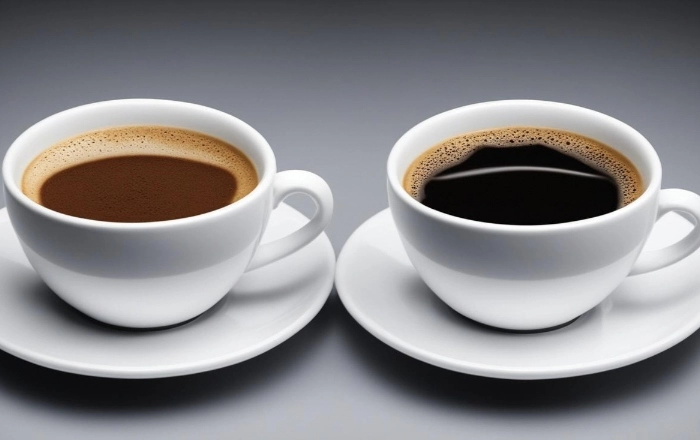When it comes to caffeine content, espresso and regular coffee often spark debates. Many assume espresso has more caffeine because of its strong flavor, but the truth is more nuanced. This article breaks down the caffeine differences between espresso and coffee, covering brewing methods, serving sizes, and factors that influence caffeine levels.
Understanding Caffeine in Espresso and Coffee
Caffeine is a natural stimulant found in coffee beans. The amount of caffeine in your drink depends on several factors, including:
- Type of coffee bean (Arabica vs. Robusta)
- Brewing method (espresso, drip, French press, etc.)
- Serving size (a single shot vs. a large cup)
- Roast level (light, medium, or dark)
Espresso and drip coffee differ in preparation, which affects their caffeine content. Let’s explore how.
How Much Caffeine is in a Shot of Espresso?
A standard single shot of espresso (about 1 oz or 30 ml) contains 63 mg of caffeine on average. A double shot (2 oz or 60 ml) has roughly 125 mg.
Why Espresso Packs a Punch in Small Doses
Espresso is made by forcing hot water through finely-ground coffee under high pressure. This method extracts caffeine and flavors quickly, resulting in a concentrated beverage. Despite its intensity, a single espresso shot has less caffeine than a typical cup of drip coffee—but ounce for ounce, espresso is stronger.
How Much Caffeine is in a Cup of Coffee?
An 8-oz (240 ml) cup of drip coffee contains about 95 mg of caffeine, but this can vary:
Light roast: Slightly more caffeine (around 100 mg)
Dark roast: Slightly less (around 85 mg) due to longer roasting
Cold brew: Can range from 100–200 mg per 8 oz due to longer steeping
Brewing Methods and Their Impact on Caffeine
Different brewing techniques extract caffeine differently:
- Drip Coffee – Hot water drips through medium-coarse grounds, extracting caffeine gradually.
- French Press – Coarse grounds steep in water, yielding about 80–100 mg per 8 oz.
- Pour-Over – Similar to drip but with more control, averaging 90–110 mg per 8 oz.
- Cold Brew – Steeped for 12–24 hours, resulting in a smoother but often stronger caffeine content.
Espresso vs. Coffee: Caffeine Per Ounce
If we compare caffeine per ounce:
Espresso: ~63 mg per 1 oz
Drip Coffee: ~12 mg per 1 oz
This means espresso is about 5 times more concentrated than drip coffee. However, since espresso servings are much smaller, a full cup of coffee usually delivers more total caffeine.
Does Roast Level Affect Caffeine?
A common myth is that dark roast coffee has more caffeine. In reality:
- Light roast beans are denser, so by weight, they may have slightly more caffeine.
- Dark roast beans lose mass during roasting, but the difference in caffeine per cup is minimal.
The brewing method and serving size matter more than roast level when comparing caffeine content.
How Do Coffee Beans Influence Caffeine?
There are two main types of coffee beans:
- Arabica – Smoother, sweeter, and contains about 1.2% caffeine.
- Robusta – More bitter, with nearly 2.2% caffeine—almost double that of Arabica.
Most specialty coffees use Arabica, while cheaper blends or espresso mixes may include Robusta for extra caffeine and crema.
Does Decaf Espresso or Coffee Have Caffeine?
Yes, but in very small amounts:
Decaf espresso: ~3–15 mg per shot
Decaf coffee: ~2–5 mg per 8 oz
Decaffeination removes 97% or more of caffeine, but trace amounts remain.
How to Control Your Caffeine Intake
If you’re sensitive to caffeine, consider:
- Choosing single shots of espresso instead of doubles.
- Opting for half-caff blends (mix of regular and decaf).
- Drinking smaller cups of drip coffee.
- Selecting Arabica beans over Robusta.
The answer depends on how you measure it
Per ounce: Espresso has more caffeine.
Per serving: Drip coffee usually contains more total caffeine.
If you want a quick, strong caffeine kick, espresso is ideal. If you prefer sipping a larger, milder drink, drip coffee may be better.
Final Tips for Caffeine Lovers
- Check serving sizes—a 12-oz latte has more caffeine than a single espresso shot.
- Experiment with brewing methods to find your ideal caffeine level.
- Listen to your body—caffeine tolerance varies per person.
Conclusion
Now that you know the differences, you can enjoy your coffee (or espresso) with confidence! Ultimately, the best choice depends on your preference for strength, serving size, and how your body reacts to caffeine. Whether you enjoy the bold punch of espresso or the steady lift of brewed coffee, understanding these differences helps you make informed decisions for your daily caffeine fix.
Related topics:
How to Brew Espresso in Keurig
Is There More Caffeine in Espresso or Coffee?
How Much Caffeine is in Espresso vs. Coffee?


